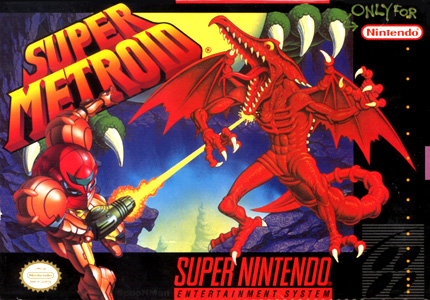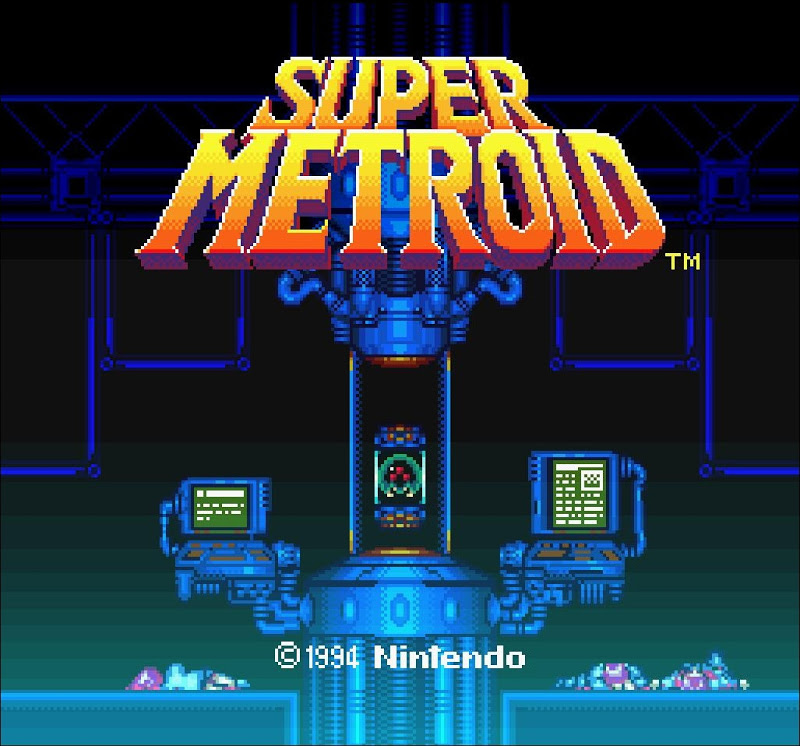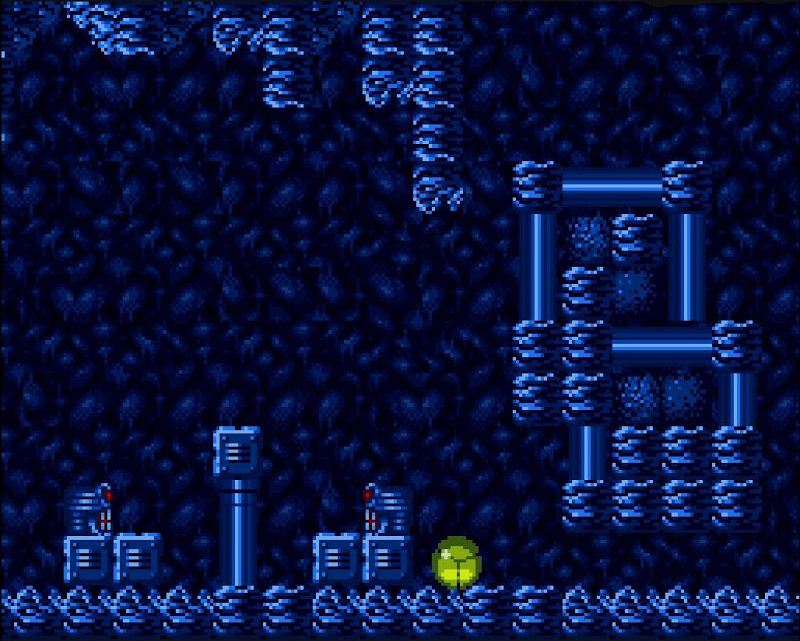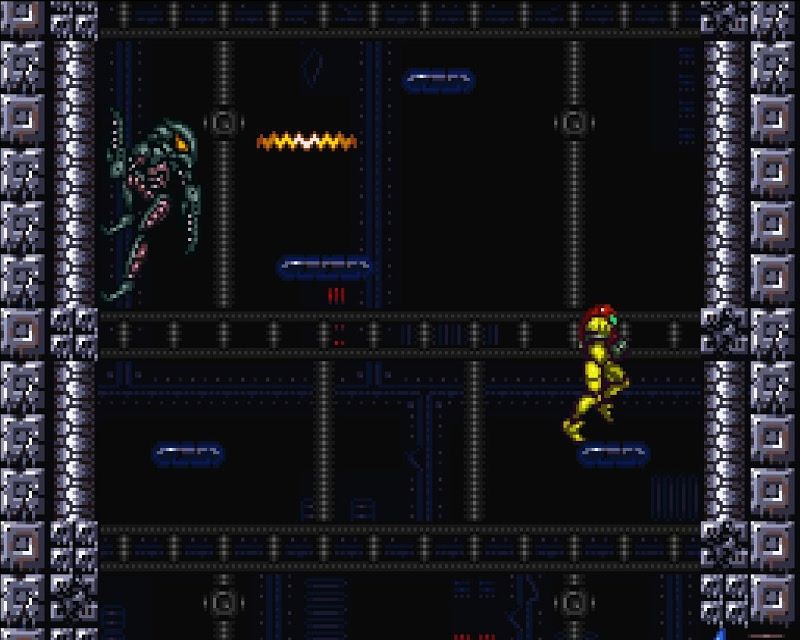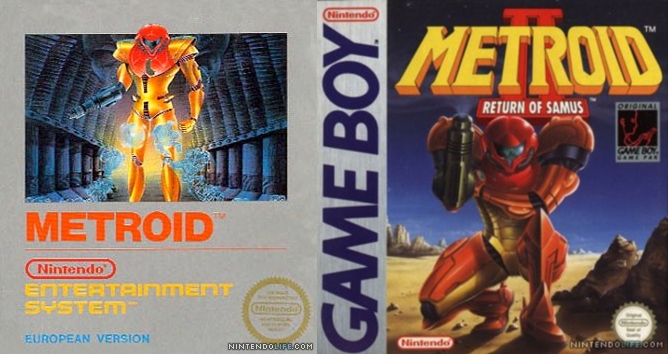
This time we’re also heading back to days gone by in search of a long-lost Nintendo treasure; however… we’re going 16-bit this time, with the Super Nintendo Entertainment System!
This time I’m gonna tell you everything (that I know/remember/isn’t spoiler-heavy) about a 2D gem from 1994, called Super Metroid. A game in a series that – along with Castlevania – spawned an entire genre in gaming: Metroidvania. What Metroidvania refers to are action/adventure titles that take place in 2D with a heavy emphasis on exploration. Examples of recent games placed in that genre, are Shadow Complex and Terraria. Both of these feature many elements from the early Metroid and Castlevania games, including a semi-advanced upgrade system, alongside the aforementioned features that define that specific genre.
It wasn’t the first or even the second Metroid game…
I would love to start from the first in a franchise/series and move on from there, but sadly neither Metroid (NES) nor Metroid II: Return of Samus (GB) were as appealing to me, and I’m certain most people will agree with me when I say that the first two Metroid games were “raw”.
There is no doubt that they were both great games, but one thing neither could claim was to be user-friendly. In the first game, you were just starting out as your bounty hunter career so maybe that was why it felt so, well, raw? Could also have been hardware limitations, though I still say a map would have been nice in Metroid – would have led to much less frustration at least, while not making the game too easy by far. In Metroid and Metroid II you had to figure just about everything out on your own… no 20-minute tutorials there (or even tutorials period!). Let’s not forget about another feature – or lack thereof – that made the game rather difficult compared to pretty much any today: there was no way to save your game, outside of a password system. This, combined with the lack of any kind of in-game map, made for a challenging classic. Not a bad game, just a difficult one.
But wait a minute… this is about Super Metroid, not the two earlier games, so let’s get back on track, shall we?
Time for introductions!
The main character in the Metroid series is Samus Aran, an intergalactic bounty hunter with a rather unique piece of armour – one I’ll talk about in greater detail later. It’s hard to really “introduce” this game, without spoiling the plot, so I’ll keep it brief:
The story in the Metroid series can be rather confusing, as the plot does not follow the games in order of release. When Super Metroid was released in 1994, there were only two other Metroid titles, but since then there have been more than a few across several Nintendo platforms (including handheld devices), each with their own place on the timeline.
The main events of the first two games were shown in flashbacks during the beginning of Super Metroid so those who had not played them would not be left entirely in the dark. Thank you, Nintendo, for even though those two may have started the franchise… they were not the easiest to play.
“Growing up without a SNES..”
Today big games get a lot of hype and attention prior to release, but this was a different time. One without videos all over the Internet showing off flashy trailers from upcoming games or Facebook/Twitter/Google+/MySpace/etc. to aid in spreading information further and faster than by word-of-mouth, but that did not mean this game was simply a random choice among many. As I recall, it was the box art (as shown above) that got my attention first and foremost, which is funny ’cause… I never did have my own copy.
Playing Super Metroid back in the day, meant going to a friend’s place; but the game certainly got played a bit, even so. Never did finish it though… and my friend had to move away as kids sometimes do; so since I did not own a SNES, there was to be no more Super Metroid (for a while at least).
But as the years went by…
I did not forget about Samus Aran and her adventures on the SNES; quite the contrary. As I described earlier, the game helped spawn an entire genre (with the help of Castlevania); so whenever I played that game – seeing how a Castlevania title was released on pretty much any console, including handhelds – my mind drifted back to Super Metroid. Almost as if it was calling to me from all those years ago…
It was not just Castlevania though. Every time I played a 2D platformer in which upgrades were available, be it Wonderboy In Monster Land at the arcade or Mega Man X3 on the PlayStation, I wanted to morph into a ball and drop bombs…
Time for a brief 2D history of the series
In 1986, the first Metroid game was released on the NES, as I mentioned earlier in this blog, and it was not an easy game to pick up and play. Great game, just rather difficult. But then, 18 years later, Nintendo unleashed Metroid Zero Mission on the GameBoy Advance. This was not a brand-new game, but a more “user-friendly remake” of the original Metroid. Not only did it bring a map feature to the table (or screen… get it?), it also added new areas, items and mini-bosses; so while not a 1:1 remake with a map feature, it was still a great game that scored high in reviews.
GameBoy Advance owners got an original Metroid entry too, with Metroid Fusion in 2002. This was developed by the same team responsible for Super Metroid; and it showed, though none were negative. Just like Metroid Zero Mission, it received positive reviews, in no small part due to the fact that it was structurally very different from earlier Metroid titles; not in a negative way, but after Metroid (1986), Metroid II (1991) and Super Metroid (1994) it was good to see Nintendo mix the recipe up a bit with Metroid Fusion. The exploration aspect, power suit and abilities/upgrades remained. Yet certain things were added or changed. In my opinion, for the better.
Colored doors, exploration, and conclusion…
Why hello there Super Metroid… how have you been?
The game began with Samus Aran answering a distress signal, immediately putting you in control of said character without anything even remotely resembling a tutorial. You were completely on your own from the second you started playing, and while you had the rare (in a game from 1994) option of remapping your controls before starting a new game. There were still a lot of things to familiarize yourself with, though only basic moves and actions were available at first, this game featured a rather unique (again, for 1994) upgrade system.
Samus Aran, like in earlier Metroid games, start out with little more than a power suit – a piece of armor covering her entire body, with upgradeable parts and a unique visor (quite like Iron Man..). This power suit was both a defensive and offensive item at the same time since it was where Samus stored weapon upgrades and enhancements, while also acting as a defensive shield (hence the “armor” part); impressive technology!
Power Suit? Upgrades?
This was a game with a strong emphasis on exploration, but at the same time, not one where you could simply traverse any terrain as you saw fit, going wherever you wanted to; not at first anyway, and this was where the colored doors (among other unique features) came into play!
As you moved around, exploring this new unfamiliar territory, one thing you’d quickly notice was that certain paths were inaccessible. For example, a tunnel blocked off by what looks like stone cubes. You just knew there had to be something behind them, yet you could not find a way to get through; a path too narrow to even crawl through – even certain doors were seemingly locked!
In most games these days, doors open due to a proximity sensor or you press the “use” key while standing in front of one. But in Super Metroid, you had to actually attack doors to open them! Before you start thinking about ammo and all that, let me clarify how doors worked here: each had a unique color, signifying a certain type of attack required to open it, and while only your main weapon had unlimited ammo, restocking other types was as simple as killing enemies, seeing how they would drop health (unless you were at 100%) and various ammo types, as long as you had acquired access to said type.
While I could go into a long paragraph about every single upgrade you’d come across, I would rather leave that 99% unspoiled, and just talk about one tied directly to exploration. I will be spoiling a bit, and for that, I do apologize, but it is something you’ll see for yourself within the first 15-20 minutes anyway, so say hello to the first upgrade in Super Metroid: the Morph Ball. Also, the game is from 1994. Not exactly spoiling a brand-new game here.
It’s morphing time!
Upon picking up the Morph Ball upgrade, Samus gained the ability to morph into a ball (hence the name of the upgrade) – which proved vital to your progression through major parts of the game. That may sound a bit odd, for what good could the ability to roll into a small ball really be? Remember those narrow passages I mentioned earlier? Morph and roll baby! It was also easier to dodge certain enemies or attacks from such, in ball form – since as a ball you were obviously a smaller target. So while meant for exploration, it had its uses in combat too. This was however only the first of many upgrades required to reach previously unavailable areas… and you had to re-visit the same areas later in the game, to collect every last upgrade; in a way, you could say that suit upgrades acted like really odd keys.
“Combat”? Yeah! Those darn aliens…
Since Samus was packing heat from the beginning, it was obvious there would be enemies to deal with, and boy were there ever bad guys to fight. They came at you in all different shapes and sizes, some even required different weapons to get rid of, but there were no borderline impossible battles, and all enemies left behind health (as previously mentioned), so it could have been much more difficult.
Also, while saving your game meant going to one of many specific locations – through hostile territory most likely – I only died so many times on my way to saving the game. So while that feature may seem chaotic and crazy today, it wasn’t that bad. And “bad” is not how this game looked or sounded either – far from. This was a game that pushed the hardware – if only a bit. Star Fox and F-Zero both pulled off much more incredible visual features, but Samus Aran’s adventures on the SNES did still sport a high level of detail, not only visually, but also in the audio department. The textures were nicely detailed with some sections even showing animated backgrounds; particularly in flooded areas.
The sound effects for just about everything were spot-on and the music is still memorable to this day, though as I write this I can’t help but wonder how amazing an orchestrated version of the Super Metroid soundtrack would sound…
This game was great for speedruns!
In the years following its release, and even more so now that it’s available on the Wii’s Virtual Console, the more dedicated Super Metroid players found out that completing the game within a certain time limit meant getting a different/longer ending. Obviously, this lead to experimenting, people trying to find the fastest way to beat the game and thus, Super Metroid became another title that had people going crazy, making/recording speedruns either for the competitive aspect or simply to challenge themselves. Not something I ever got into with any game, but great fun, I’m sure.
While this was a lengthy game for those going for the fabled 100% completion, if you were instead going for the “best” ending, you had to finish it in less than 3 hours!
Want to play a game of… Super Metroid?
As is the case with most SNES classics today, the price tag on eBay can be ridiculous and the console itself ain’t exactly cheap – or easy to find – either. But there’s no need to panic: Super Metroid is available on the Wii‘s Virtual Console; complete with the addition of a “save anywhere” feature, which helps a lot when the real world calls you away from the game, as saving the game in the original version was only possible at specific locations. Doing it that way worked back in 1994, but today most people are likely going to find that system annoying (and hey, no one is forcing you to use anything but the original save feature if you want to stay old-school). So if you have a Wii, I urge you to go spend 800 Nintendo Points (or $8 in real money) on Super Metroid, right now!


